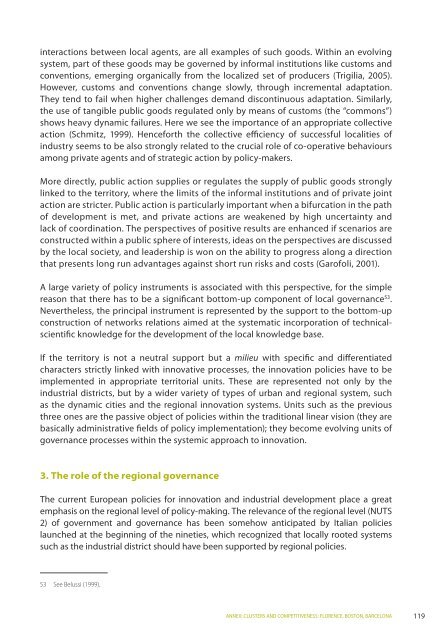Clusters and competitiveness - PRO INNO Europe
Clusters and competitiveness - PRO INNO Europe
Clusters and competitiveness - PRO INNO Europe
Create successful ePaper yourself
Turn your PDF publications into a flip-book with our unique Google optimized e-Paper software.
interactions betweenlocalagents,areallexamplesofsuchgoods.Withinanevolving<br />
system,partofthesegoodsmaybegovernedbyinformalinstitutionslikecustoms<strong>and</strong><br />
conventions, emerging organically from the localized set of producers (Trigilia, 2005).<br />
However, customs <strong>and</strong> conventions change slowly, through incremental adaptation.<br />
They tend to fail when higher challenges dem<strong>and</strong> discontinuous adaptation. Similarly,<br />
the useoftangiblepublicgoodsregulatedonlybymeansofcustoms(the“commons”)<br />
showsheavydynamicfailures.Hereweseetheimportanceofanappropriatecollective<br />
action(Schmitz,1999).Henceforththecollectiveefficiencyofsuccessfullocalitiesof<br />
industryseemstobealsostronglyrelatedtothecrucialroleofco-operativebehaviours<br />
among private agents <strong>and</strong> of strategic action by policy-makers.<br />
More directly,publicactionsuppliesorregulatesthesupplyofpublicgoodsstrongly<br />
linkedtotheterritory,wherethelimitsoftheinformalinstitutions<strong>and</strong>ofprivatejoint<br />
action are stricter. Public action is particularly important when a bifurcation in the path<br />
of development is met, <strong>and</strong> private actions are weakened by high uncertainty <strong>and</strong><br />
lack ofcoordination.Theperspectivesofpositiveresultsareenhancedifscenariosare<br />
constructedwithinapublicsphereofinterests,ideasontheperspectivesarediscussed<br />
bythelocalsociety,<strong>and</strong>leadershipiswonontheabilitytoprogressalongadirection<br />
that presents long run advantages against short run risks <strong>and</strong> costs (Garofoli, 2001).<br />
Alargevarietyofpolicyinstrumentsisassociatedwiththisperspective,forthesimple<br />
reason that there has to be a significant bottom-up component of local governance 53 .<br />
Nevertheless, the principal instrument is represented by the support to the bottom-up<br />
construction of networks relations aimed at the systematic incorporation of technicalscientific<br />
knowledge for the development of the local knowledge base.<br />
If theterritoryisnotaneutralsupportbutamilieu with specific <strong>and</strong> differentiated<br />
characters strictly linkedwithinnovativeprocesses,theinnovationpolicieshavetobe<br />
implemented in appropriate territorial units. These are represented not only by the<br />
industrial districts, butbyawidervarietyoftypesofurban<strong>and</strong>regionalsystem,such<br />
asthedynamiccities<strong>and</strong>theregionalinnovationsystems.Unitssuchastheprevious<br />
threeonesarethepassiveobjectofpolicieswithinthetraditionallinearvision(theyare<br />
basicallyadministrativefieldsofpolicyimplementation);theybecomeevolvingunitsof<br />
governance processes within the systemic approach to innovation.<br />
3. The role of the regional governance<br />
The current <strong>Europe</strong>an policies for innovation <strong>and</strong> industrial development place a great<br />
emphasis on the regional level of policy-making. The relevance of the regional level (NUTS<br />
2) ofgovernment<strong>and</strong>governancehasbeensomehowanticipatedbyItalianpolicies<br />
launchedatthebeginningofthenineties,whichrecognizedthatlocallyrootedsystems<br />
such as the industrial district should have been supported by regional policies.<br />
53 See Belussi (1999).<br />
ANNEX: CLUSTERS AND COMPETITIVENESS: FLORENCE, BOSTON, BARCELONA<br />
119
















